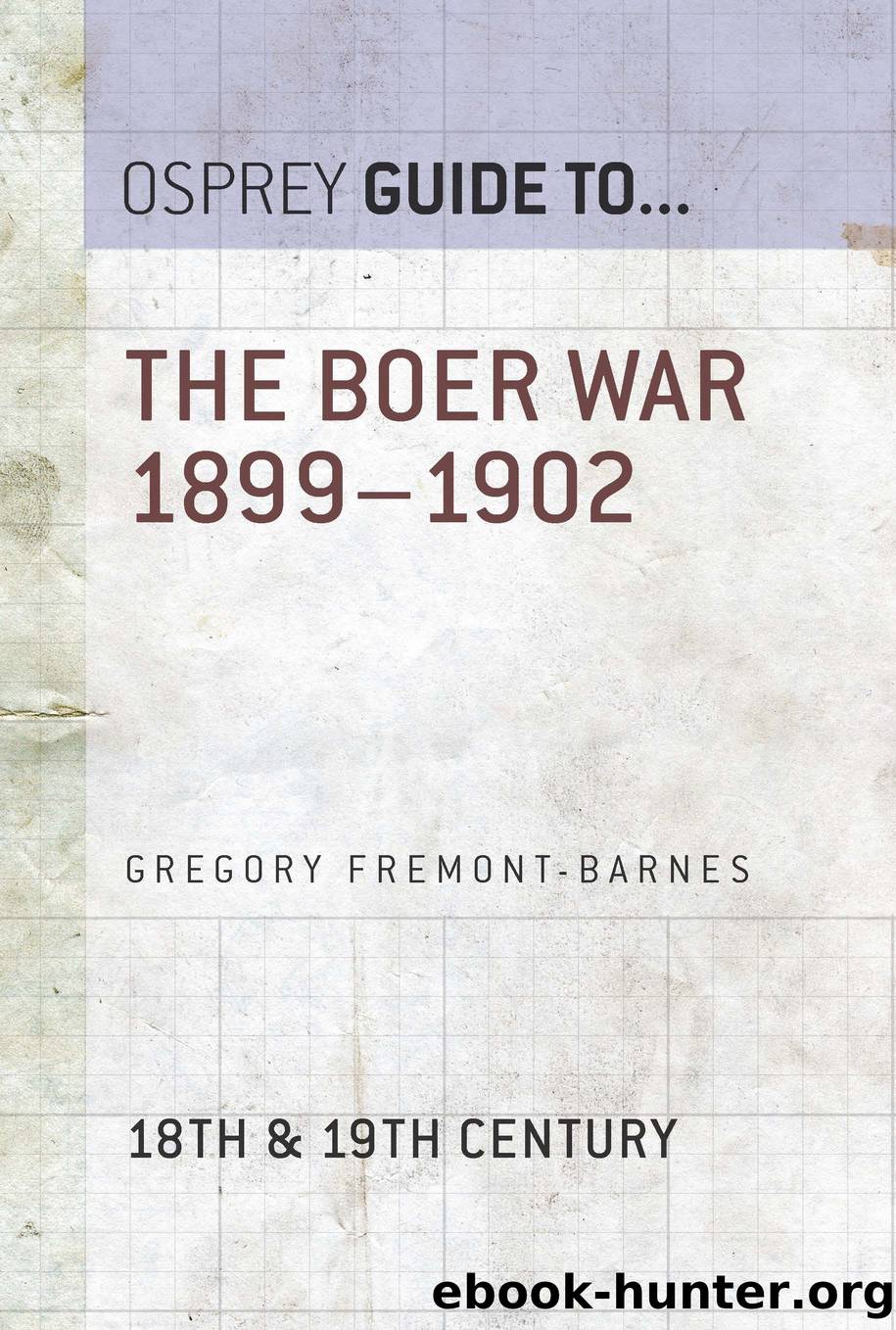The Boer War 1899–1902 by Gregory Fremont-Barnes

Author:Gregory Fremont-Barnes
Language: eng
Format: epub
Tags: The Boer War 1899–1902
ISBN: 9781472810175
Publisher: Osprey Publishing Ltd
The guerrilla phase
The fall of Bloemfontein and Pretoria did not bring the war to an end, as Roberts initially believed. On the contrary, the war merely entered a new phase that was to last another two years. Indeed, evidence of the Boers’ willingness to carry on the struggle quickly became obvious to Roberts, who appreciated that large areas in both republics remained beyond British control. In particular, his line of communication through the Orange Free State was inadequately defended and open to attack at numerous points. Notwithstanding the loss of their capitals the Boers enjoyed some advantages. Those leaders who remained in the field were largely young, determined and imaginative and, no longer obliged to defend the capitals, they could deploy the remaining commandos as guerrillas.
By this time there were perhaps only 25,000 Boers still offering resistance, but they were well mounted and elusive, with up to 400,000 sq km (about 150,000 square miles) in which to operate. The Boers, moreover, understood the terrain far better than their adversaries, who continued to rely on the railway lines and larger towns for their supplies. The countryside could not be completely controlled, a fact which left the British with an apparently insoluble problem, and one that would be faced on many future occasions by modern and sophisticated armies later in the 20th century.
Roberts made an early and concerted effort to quash the guerrilla movement. First, he issued proclamations on 31 May and 1 June, meant to persuade the burghers still in the field to hand in their weapons. Next, on 16 June he followed this up with a new, more drastic decree: if the Boers struck railway and telegraph lines and stations, homes and farms in the area of these attacks would be put to the torch. Such forms of retaliation had been practiced on an ad hoc basis since the beginning of the year: now Roberts made the policy official, providing a legal precedent for the more comprehensive ‘scorched earth’ policy to be applied by Kitchener in the following year.
In the field itself, Roberts opened an offensive intended to drive the Free State forces eastwards in order to trap them against the Basutoland border in a pincer movement during June and July 1900 in what became known as the ‘first De Wet hunt.’ He took Bethlehem on 7 July and compelled the Free State forces to take refuge behind the Witteberg Range. De Wet and Steyn, with 2,000 men and the Free State Government, managed to elude forces under Lieutenant-General Sir Archibald Hunter (1856–1936), but Marthinus Prinsloo was forced to surrender about 4,400 men, half the remaining Free State forces, on 30 July.
De Wet, meanwhile, showed himself a master of maneuver and deception, easily outwitting his pursuers as he escaped across the border into the Transvaal, despite the fact that as many as 50,000 troops in converging columns sought to destroy him. Free State commandos all the while struck with considerable success against the railway lines, notably the line linking Potchefstroom and Krugersdorf.
Download
This site does not store any files on its server. We only index and link to content provided by other sites. Please contact the content providers to delete copyright contents if any and email us, we'll remove relevant links or contents immediately.
| Africa | Americas |
| Arctic & Antarctica | Asia |
| Australia & Oceania | Europe |
| Middle East | Russia |
| United States | World |
| Ancient Civilizations | Military |
| Historical Study & Educational Resources |
Goodbye Paradise(2961)
Men at Arms by Terry Pratchett(2404)
Tobruk by Peter Fitzsimons(2060)
Pirate Alley by Terry McKnight(1908)
Arabs by Eugene Rogan(1835)
Borders by unknow(1785)
Belonging by Unknown(1465)
The Biafra Story by Frederick Forsyth(1321)
It's Our Turn to Eat by Michela Wrong(1301)
Botswana--Culture Smart! by Michael Main(1237)
A Winter in Arabia by Freya Stark(1223)
Gandhi by Ramachandra Guha(1195)
Coffee: From Bean to Barista by Robert W. Thurston(1180)
Livingstone by Tim Jeal(1151)
The Falls by Unknown(1141)
The Source by James A. Michener(1133)
The Shield and The Sword by Ernle Bradford(1100)
Egyptian Mythology A Fascinating Guide to Understanding the Gods, Goddesses, Monsters, and Mortals (Greek Mythology - Norse Mythology - Egyptian Mythology) by Matt Clayton(1086)
Africa: Altered States, Ordinary Miracles by Richard Dowden(1078)
